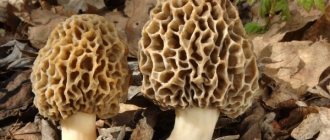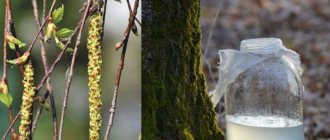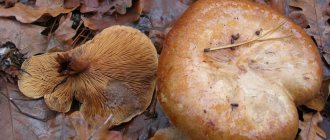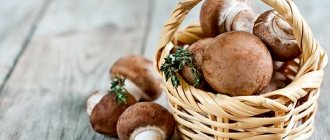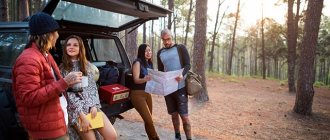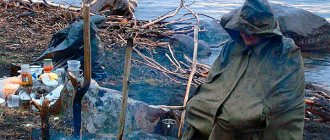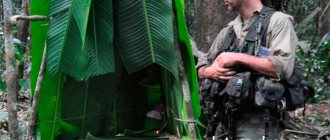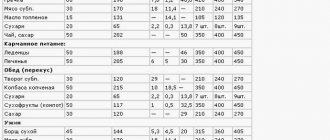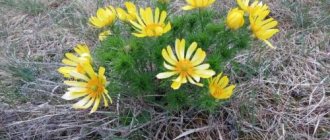- October 10, 2019
- Man in the wild
- Victoria Stitch
Mushroom lovers are looking forward to the time to go for their favorites. Such a hobby remains for life and cannot but rejoice. Even when it’s not the picking season, the mushroom picker’s eye still runs through the bushes and under the trees in search of a barely noticeable cap or white stem. An eternal question that worries all avid mushroom pickers: how to pick mushrooms correctly: cut or tear? Any trip for mushrooms turns into a pleasant walk and pastime. In this article we will look at how to pick mushrooms.
Legends about mushroom picking
Usually our childhood was somehow connected with going to the forest to pick mushrooms. This could be a trip with the whole family or a trip for two or three people. Those leading such an “event” often said that mushrooms should not be picked, but only cut with a knife. Otherwise, not a single mushroom will ever grow in this place again. After all, the mycelium underground will be damaged. But in order not to be afraid of different opinions, it is important to know how the mushroom and its mycelium work. Then you can answer the question of how to pick mushrooms correctly: cut or tear. Let's get acquainted with the opinion of representatives of science.
Penalties for mushrooms: rules for collecting nature's gifts have been tightened in Russia
New rules for collecting berries, mushrooms and birch sap have been introduced for Russians. Two orders of the Ministry of Natural Resources came into force: on the rules for the procurement and collection of non-timber forest resources (No. 496) and on the rules for the procurement of food forest resources (No. 494).
According to these documents, from now on, any grandmother who stands with a basket on the highway and sells mushrooms, berries or birch sap can be approached at any time by servants of the law and demanded to present a lease agreement for the forest plot where the goods were collected, and also to check whether they comply mushroom caps to approved standards. You can only eat the mushrooms for free yourself.
In a word, in order to avoid misunderstandings, before each trip to the forest it is better to refresh your memory of the list of rules of the Ministry of Natural Resources and stock up on evidence that the collection will be carried out on a permitted plot of land. For example, those who want to collect birch sap must rent a piece of forest. At the same time, it will be possible to “connect” the extraction tap to the tree symbol of Russia only in areas of mature forest and only if no more than 5 years remain before its planned felling.
The situation is the same with berries and mushrooms. If you collect them for sale, you need a lease agreement for a certain area of the forest. Beekeeping exclusively for your own dinner table will be possible without a mandate, but “silent hunting” must be carried out without causing harm to nature.
Photo: Forestry Committee of the Moscow Region
Therefore, a requirement for the size of mushrooms is also introduced. It is prohibited to collect chanterelles, honey mushrooms, russula, champignons and boletus with a cap diameter of less than one and a half centimeters, and milk mushrooms, saffron milk caps, capillaries, porcini mushrooms, aspen and boletus mushrooms must be less than two and a half centimeters. There is generally criminal liability for collecting poisonous mushrooms that have toxic and narcotic effects.
The introduction of new collection rules will not replenish the budget in any way, says Anna Bodrova, senior analyst at Alpari IAC. In her opinion, the introduced requirements can only significantly reduce the number of people willing to sell mushrooms and berries along the highway.
“Too much is left to the human factor, and in Russian realities this means that the standards will be used in a way that is beneficial to the inspector,” the expert is convinced. — Requirements for the size of mushrooms are normal, but again in Russian realities it is impossible to apply such standards, as well as to check their compliance. As for collecting birch sap, the rules regarding forest lease are an adequate measure, but in reality it will be almost impossible to select an adequate lease scheme, fill out the relevant documents and pay taxes.”
What do scientists say: cut mushrooms or twist them?
There is a lot of controversy between mushroom pickers. Everyone wonders whether they are picking mushrooms correctly and whether they are causing harm to nature. Some people believe that the twisted mushroom damages the mycelium, while others say that after cutting off, the remaining part rots and damages the mycorrhiza.
Scientists are revealing useful information about whether to cut or pick mushrooms. Even in such an ancient method of gathering, you need to get your food using your mind. According to scientists, when cutting, an infection can get on the cut, which will spread further to the mycelium, and it will get sick. And if you pull it out, the mycelium itself may be damaged. Therefore, scientists are in favor of twisting the mushrooms and cutting off the dirty part of the stem.
How to assemble correctly: cut or twist
Experienced mushroom pickers constantly argue about how to properly collect forest products, cut or twist. Let's try to answer this question from a scientific point of view.
Figure 2. Correct collection: twisting
The popular opinion is that the leg must be cut off with a sharp knife. It’s worth noting right away that they cannot be broken: through an uneven cut, an infection can enter the wound, which will destroy the mycelium.
But experienced mushroom pickers know that for the same reason it is better to twist the gifts of the forest (Figure 2). The part of the leg remaining in the ground will rot and may cause the death of the mycelium. When twisted, only the mycelium itself remains in the soil, which will produce a new harvest next year.
Structure and types of mushrooms
Basically, the mushroom has an aboveground and underground part. The aboveground part includes the fruiting body - this is the cap and the stem, what we see when picking mushrooms in the forest. The underground part consists of mycelium (mycelium). When the fruiting body is torn off, the mycelium remains in the ground, it breaks off only in the place where it turns into the stem, so whether the mushroom is cut or twisted does not matter. The rotting process does not begin. But there is one peculiarity in such doubts among mushroom pickers, and it arose on the basis of the different structure of mushrooms. To answer whether to cut or twist mushrooms correctly, let’s look at the structure of different mushrooms. So, what do you need to know if we are collecting different types of mushrooms?
How to pick mushrooms in the forest
A brief reminder of the rules for collecting mushrooms is as follows:
- In any case, resolutely throw away unfamiliar mushrooms, even if you have even the slightest doubt, remember that even one questionable fungus can cost you your life.
- For the first time or with little experience, go to the forest with experienced mushroom pickers who are familiar to you personally, use reference books.
- Following the basic rules, mushroom picking should be carried out in environmentally friendly places, away from cities and large industrial enterprises, at a distance of at least 500 meters from highways.
- Do not take old mushrooms or specimens with even slight signs of mold.
- Mushrooms should be harvested, preserved and stored according to the recipes of experienced specialists.
- Never buy mushrooms from unknown sellers or in the absence of an officially registered store.
Look at the photo of how to pick mushrooms in the forest:
Go to the forest in thick, closed clothing, always with a hat, use mosquito and tick repellent, shake out your clothes after a walk in the forest, consult a doctor immediately if you find ticks on your body (in some areas ticks are not encephalitic and at the first sign of poisoning fruiting bodies.This video details how to properly collect mushrooms in the forest:
How to pick mushrooms correctly depending on the type: cut or tear
However, depending on the type of mushroom, there is still a more preferable collection method.
Tubular mushrooms with thick stems (white mushrooms, aspen mushrooms, boletus mushrooms, boletus mushrooms) are best twisted. When cut, part of the stem remains in the ground, because in such mushrooms it is half buried. Honey mushrooms, champignons, russula, umbrella mushrooms and chanterelles are best cut off. These mushrooms are lamellar, and the stem can simply crumble.
Mushroom picking technique - cut or twist
You also need to pick mushrooms wisely. Scientists explained how to do it correctly. There are only two options: you can cut or pick the mushroom. Some mushroom pickers believe that the part remaining after cutting the mushroom rots and spoils the mycelium, so they pick off their treasures. Their opponents believe that twisting the mushroom can also damage the mycelium. Scientists assure that both methods are suitable. When the fruiting body is torn off, the mycelium remains in the ground; it breaks off only in the place where it turns into a stalk. And the theory about the mycelium rotting after cutting also has no objective basis. However, depending on the type of mushroom, there is still a more preferable collection method.
Tubular mushrooms with thick stems (white mushrooms, aspen mushrooms, boletus mushrooms, boletus mushrooms) are best twisted. If you cut off such mushrooms, part of the stem remains in the ground, because in such mushrooms it is half buried. “Family” mushrooms, for example, honey mushrooms, are best cut off. You should not touch the “babies”, giving them the opportunity to grow up and become a full-fledged mushroom. This collection method is also suitable for lamellar mushrooms (champignons and russula), otherwise their fragile legs may crumble. And the most important rule that mycologists ask you to pay attention to. You should not trample old mushrooms that you definitely do not plan to put in your basket. These mushrooms are the source of spores, that is, the continuation of the mushroom “genus”.
Since ancient times, it has been the custom that you only need to go into the forest to pick mushrooms with a knife to cut them. Grandfathers and grandmothers also taught their children, and then their grandchildren, that the mycelium will disappear if the mushroom is pulled out from the ground.
Mycologists decided to explain the essence of the structure of the mycelium in order to debunk the myth that is not clear where it came from. In the ground there is mycelium, from which mushrooms actually appear. On the surface is the fruiting body itself - the stem and cap of the mushroom. There are millions of spores in the ground, which, under favorable conditions, enable the fungus to grow.
Twisting the mushroom.
Mycelium can be created on the roots of trees. In this case, it additionally nourishes the tree, and it supplies the mushroom with the necessary substances for growth. They get mutual pleasure for growing. Therefore, in order to pull out a mushroom so that it does not reappear in the same place, you need to uproot the tree itself right from the roots. And then for some time, under favorable conditions, mushrooms can grow directly on pieces of wood or roots.
How to properly cut mushrooms
Mushrooms are cut with a knife as close to the base as possible. In this case, the second hand supports the leg or cap. Before cutting, you need to evaluate the ripeness of the mushroom. Old mushrooms do not need to be cut off; they have already accumulated toxic substances and insects. But the young, small ones must be left to grow up. Do not trample or knock down mushrooms that do not fit. It is better to hang the mushroom on a tree; it will dry out and be eaten by an animal passing by. Also, if the mushroom is sick, then when it touches shoes, the infection will spread throughout the forest and infect other myceliums.
How to pick mushrooms correctly - the opinion of scientists
Mycologists do not see any difference in whether the mushroom is cut or twisted from its place of growth. There are only small nuances that relate to the types of mushrooms.
In what cases are mushrooms twisted?
Tubular mushrooms with thick stems can be twisted. These include porcini mushrooms, aspen mushrooms, boletus mushrooms, and boletus mushrooms. Not the entire stem of the mushroom is on the surface. Considering that a third of it is hidden in the ground, then the same amount can be lost from the harvest. To get the mushroom out of the ground, you need to shake it a little and twist it until it gives a slight crunch. It can be easily removed, and the lower, dirty part can be cut off at home.
When to cut mushrooms
You can use a knife to cut mushrooms in cases where the mushrooms are lamellar. These are milk mushrooms, saffron milk caps, volushki and the like. They have a delicate leg that can crumble when twisted. Mushrooms that grow in a bunch are cut off. Usually these are small ones, or those that are found on tree trunks. They grow in groups and without harm to the mycelium or the mushroom itself; they cannot be picked up by hand. The same applies to mushrooms growing from moss. Mushrooms are cut as close to the ground or tree trunk as possible. The remaining part will rot, and other mushrooms will grow in this place.
Interesting read: White milk mushroom and its doubles
What mycologists do not recommend doing in the forest when picking mushrooms is stomping around the mushrooms. When you see a mushroom, you need to calmly approach, take it, and just as quietly leave. This is necessary in order not to trample the mycelium, which lies close to the surface of the earth. It needs soft soil to allow new mushrooms to grow. Mushrooms are cut with a knife as close to the base as possible.
In this case, the second hand supports the leg or cap. Before cutting, you need to evaluate the ripeness of the mushroom. Old mushrooms do not need to be cut off; they have already accumulated toxic substances and insects. But the young, small ones must be left to grow up. Do not trample or knock down mushrooms that do not fit. It is better to hang the mushroom on a tree; it will dry out and be eaten by an animal passing by. Also, if the mushroom is sick, then when it touches shoes, the infection will spread throughout the forest and infect other myceliums.
Cut or twist.
Preparing for collection
If you are going for mushrooms for the first time, look at a map of the area. Find out where the nearest mushroom spots are. Learn to navigate using a compass. It is advisable to walk into the forest along highways or railways so that there is a constant reference point. There is no need to go very deep into the forest.
A phone with GPS and a charged battery will come in handy. You need to remember how you entered the forest and what the terrain was like. Along the way, notice additional landmarks. If you enter the forest from the south, then you need to exit to the north. If you plan to go deeper into the forest, do it only when you have a group of mushroom pickers with you. You can attach brightly colored cloths so as not to lose your way.
To have a successful mushroom picking trip, you need to be well prepared. Find out the weather from official sources or according to folk signs. When the weather is expected to be clear, the sun will be bright red at sunset. At night you can see the stars in the sky. The dew dries out quite quickly. If cloudy or rainy weather is expected, then crows may fly high, the clouds are low. In any case, you need to go early in the morning, while the sun's rays have not yet filled the forest. This will make it easier to see hidden pets.
If you get lost, you need to listen and move in the direction of the sound of water or noise from the road. When you reach a body of water, keep moving along the shore, as rivers flow into large bodies of water and there may be people not far from them.
Mushroom Hunter Tools and Attributes
It is important to choose comfortable clothes. Here you can build on the weather and personal feelings. But it is important that all areas of the body are covered. In the forest there are always mosquitoes, midges, horseflies, as well as poisonous or thorny plants. To avoid damage to the skin, you need to cover it with at least one layer of fabric.
The head must be wearing a headdress: a cap, bandana, scarf or hat. Everyone will have their own option.
When picking mushrooms in spring or autumn, these should be rubber boots. In summer, high boots or sneakers are quite suitable, since the foot needs to breathe. Shoes should be comfortable so as not to cause discomfort.
Container for mushrooms. Of course, here we remember the good old basket.
But you can also buy or make backpacks with a hard insert inside, this design is called “tues”.
A simple or special mushroom knife with a brush and a curved blade will serve as a working tool.
You can immediately peel the mushroom with a knife, freeing yourself from this after coming home. But it depends on personal preference.
No mushroom walk is complete without a stick. This could be an old, proven, pre-prepared cane, or one found along the way.
Of course, you need to think about unforeseen circumstances, so be sure to bring water, necessary medications, some food, matches or a lighter.
With such a set of equipment and knowledge of how to properly pick mushrooms: cut or tear, everyone is ready to collect.
Cut or twist?
Many novice collectors are interested in how to properly cut mushrooms.
The answer is simple: at the very base, near the ground. But if the leg is wormy, then it is better to cut it in a place where there are no traces of worms. If the pests have not eaten away the cap, you can only take it into the basket. How to cut mushrooms? Of course, be careful not to harm the mycelium with a knife. Under no circumstances should they simply be pulled out. Let's return to the discussion about whether to cut or twist the mushrooms, and consider the advantages of the latter action.
- You need to unscrew it if you want to pick up the entire mushroom. However, as mentioned above, this action can injure the mycelium. Therefore, it is up to you to decide what to do.
- Adherents of the twisting theory also cite in their favor the argument that when cut, the remains of the fungus that remain in the ground can become a favorable breeding ground for worms and insects, which does not benefit nature.
- It is better to unscrew mushrooms that have a full stem. These include, for example, boletus.
The way mushrooms are collected is very important, says Maxim Dyakov, a mycologist at the Faculty of Biology of Moscow State University.
Cut or pull out? This debate has been going on for a long time. But both methods are bad. When cutting, an infection can get on the cut, which will spread further to the mycelium and it will become sick. And if you pull it out, the mycelium itself will be damaged
Mycologists (mushroom specialists) recommend unscrewing the mushrooms from the substrate, and then cutting off the dirty base of the stem.
Mushroom look-alikes
Mushrooms collected in the forest can have “doubles”. How not to collect poisonous analogues instead of edible mushrooms. Look carefully in the literature or on the Internet to see what poisonous mushrooms look like, similar to those you plan to collect. No need to bite and taste them.
Let's look at the main lookalikes among the popular species among mushroom lovers:
1. The double of the porcini mushroom is called “gall mushroom”. The cap is similar to white, but lighter, but the leg has a clearly defined structure with grooves and a yellow color, which should scare away mushroom pickers.
2. Honey mushroom doubles: the first, gray-yellow, and the second, brick-red double. The most significant difference between a real honey mushroom and a false one is the presence of a ring of mushroom tissue on the stem under the cap. False mushrooms do not have such a ring. The color of the cap will also give away the doubles: it will have an orange-red tint and mucus on the surface. It's like a wet mushroom.
3. Champignon and double. It is copied by the stinking fly agaric, which at the beginning of growth emerges from the ground in the same form as the champignon in the form of a covered narrow white cap and a low skirt at the base. Also nestled here is a dangerous young lady - a pale toadstool, reminiscent of an already adult champignon. The toadstool has a light brown cap and a solid skirt under the cap.
4. Pepper mushrooms are disguised as moss mushrooms and boletus mushrooms. It, unlike its predecessors, is not poisonous, but it is not useful for food either. The taste is reminiscent of pepper and can easily be considered a seasoning. It is distinguished by a red sponge under the cap; it is very loose compared to moss mushrooms and boletus mushrooms.
5. Well-known chanterelles also have doubles. The double is distinguished by a more orange color and a round, even cap, just like the real one; the cap is uneven and directed upwards. When the double is broken, white mushroom juice will appear, which is not observed in the original.
In the event that poisonous mushrooms mistakenly end up in a basket with edible ones, it is advisable to get rid of everything collected. The fact is that any mushroom quickly absorbs substances that are nearby, and, of course, the poison will penetrate into edible mushrooms. It is better to pay with the collected wealth than to spend time in the hospital.
Signs
In general, our conversation began with the fact that last year the most superstitious mushroom lovers did not go for them, and now they are in anticipation. And I, as the youngest mushroom picker, became interested in why you can’t pick mushrooms in a leap year? I was told several versions, I’ll tell you the most memorable ones:
- Mystical version
: in the old days, people believed that if you pick mushrooms during a leap year, the spirit of the forest will take revenge and people in the village will begin to die. Naturally, there is no reliable information on this matter. - Random:
there is an opinion that the mycelium becomes poisonous every few years and releases all the accumulated harmful substances along with the mushrooms. I don’t know how much truth there is in this, but I personally am touched by the mycelium’s schedule, which coincides with leap years. - Rational version
: the mycelium is a large organism that needs nourishment and fertilizer, so it is not recommended to collect mushrooms every few years - you need to give the mycelium the opportunity to recover. Therefore, knowledgeable people either change their mushroom spots from year to year, or simply take a break during a leap year.
The remaining signs are less mystical and more substantiated. For example, in Siberia they say that when midges fly, you should prepare baskets
— the season of midge activity coincides with the mushroom season.
And in the Volga region I often hear the words “ Like a white mushroom, so is everyone brave.”
“- this means that an inexperienced mushroom picker will only pick porcini mushrooms, but an experienced one will come with a full basket anywhere - because he knows the local mushrooms.
